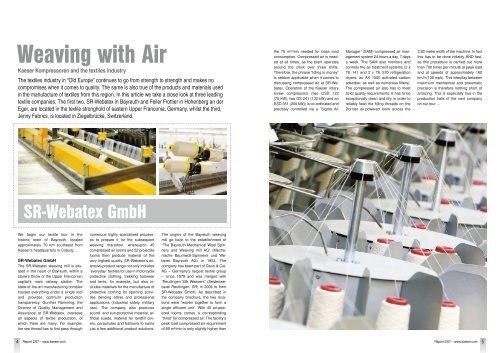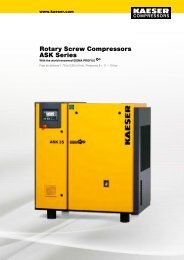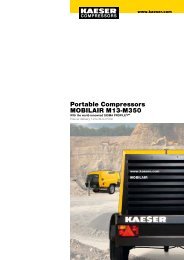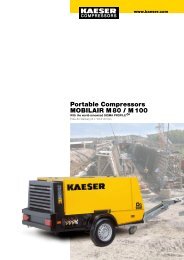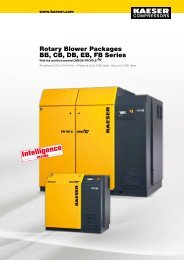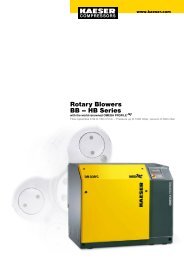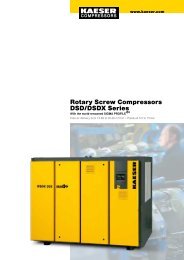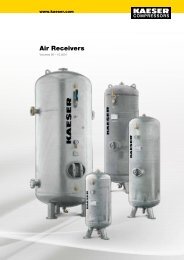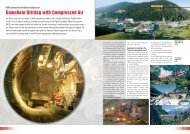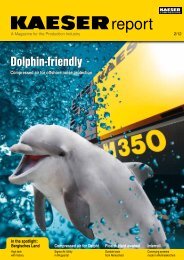Weaving with Air - Kaeser Compressors
Weaving with Air - Kaeser Compressors
Weaving with Air - Kaeser Compressors
You also want an ePaper? Increase the reach of your titles
YUMPU automatically turns print PDFs into web optimized ePapers that Google loves.
<strong>Weaving</strong> <strong>with</strong> <strong>Air</strong><br />
<strong>Kaeser</strong> Kompressoren and the textiles industry<br />
The textiles industry in “Old Europe” continues to go from strength to strength and makes no<br />
compromises when it comes to quality. The same is also true of the products and materials used<br />
in the manufacture of textiles from this region. In this article we take a close look at three leading<br />
textile companies: The first two, SR-Webatex in Bayreuth and Feiler Frottier in Hohenberg an der<br />
Eger, are located in the textile stronghold of eastern Upper Franconia, Germany, whilst the third,<br />
Jenny Fabrics, is located in Ziegelbrücke, Switzerland.<br />
We begin our textile tour in the<br />
historic town of Bayreuth, located<br />
approximately 70 km southeast from<br />
<strong>Kaeser</strong>‘s headquarters in Coburg ...<br />
SR-Webatex GmbH<br />
The SR-Webatex weaving mill is situated<br />
in the heart of Bayreuth, <strong>with</strong>in a<br />
stone‘s throw of the Upper Franconian<br />
capital‘s main railway station. The<br />
state-of-the-art manufacturing complex<br />
houses everything under a single roof<br />
and provides optimum production<br />
transparency. Gunther Ramming, the<br />
Director of Quality Management and<br />
Assurance at SR-Webatex, oversees<br />
all aspects of textile production, of<br />
which there are many: For example,<br />
the raw thread has to first pass through<br />
4<br />
SR-Webatex GmbH<br />
Report 2/07 – www.kaeser.com<br />
numerous highly specialised processes<br />
to prepare it for the subsequent<br />
weaving marathon, whereupon 45<br />
compressed air looms and 52 projectile<br />
looms then produce material of the<br />
very highest quality. SR-Webatex‘s extensive<br />
product range not only includes<br />
�everyday� textiles for use in motorcycle<br />
protective clothing, trekking footwear<br />
and tents, for example, but also includes<br />
materials for the manufacture of<br />
protective clothing for sporting activities<br />
(fencing attire) and professional<br />
applications (industrial safety, military<br />
use). The company also produces<br />
sound- and sun-protective material, artificial<br />
suede, material for landfill covers,<br />
parachutes and balloons to name<br />
just a few additional product solutions.<br />
The origins of the Bayreuth weaving<br />
mill go back to the establishment of<br />
“The Bayreuth Mechanical Wool Spinnery<br />
and <strong>Weaving</strong> mill AG” (Mechanische<br />
Baumwoll-Spinnerei und Weberei<br />
Bayreuth AG) in 1853. The<br />
company has been part of Daun & Cie.<br />
AG – Germany‘s largest textile group<br />
– since 1979 and was merged <strong>with</strong><br />
“Reutlingen Silk Weavers” (Seidenweberei<br />
Reutlingen: SR) in 2006 to form<br />
SR-Webatex GmbH. As described in<br />
the company brochure, the two locations<br />
were “woven together to form a<br />
single efficient unit”. With 45 air-powered<br />
looms comes a corresponding<br />
“thirst” for compressed air: The facility‘s<br />
peak load compressed air requirement<br />
of 85 m³/min is only slightly higher than<br />
the 75 m³/min needed for base load<br />
consumption. Compressed air is needed<br />
at all times, as the plant operates<br />
around the clock over three shifts.<br />
Therefore, the phrase “Idling is money”<br />
is seldom applicable when it comes to<br />
discussing compressed air at SR-Webatex.<br />
Operation of the <strong>Kaeser</strong> rotary<br />
screw compressors (two CSD 122<br />
(75 kW), two DS 241 (132 kW) and an<br />
ESD 351 (200 kW)) is co-ordinated and<br />
precisely controlled via a �Sigma <strong>Air</strong><br />
Manager� (SAM) compressed air management<br />
system 24 hours a day, 7 days<br />
a week. The SAM also monitors and<br />
controls the air treatment systems (2 x<br />
TE 141 and 2 x TE 570 refrigeration<br />
dryers, an AK 1000 activated carbon<br />
adsorber, as well as numerous filters).<br />
The compressed air also has to meet<br />
strict quality requirements: It has to be<br />
exceptionally clean and dry in order to<br />
reliably feed the filling threads on the<br />
Dornier air-powered loom across the<br />
3.80 metre width of the machine. In fact<br />
this has to be done reliably AND fast,<br />
as this procedure is carried out more<br />
than 700 times per minute at peak load<br />
and at speeds of approximately 160<br />
km/h (100 mph). This interplay between<br />
maximum mechanical and pneumatic<br />
precision is therefore nothing short of<br />
amazing. This is especially true in the<br />
production halls of the next company<br />
on our tour ...<br />
Report 2/07 – www.kaeser.com 5
A world full of colour:<br />
The thread store at Feiler Frottier<br />
Ernst Feiler GmbH<br />
Towelling and Chenille <strong>Weaving</strong> Mill<br />
Ernst Feiler GmbH is located directly<br />
on the German border <strong>with</strong> the Czech<br />
Republic in the town of Hohenberg an<br />
der Eger and, as Dieter Schwedt (Company<br />
Director and grandson of founder<br />
Ernst Feiler) explains, is the only weaving<br />
mill in Europe that produces chenille.<br />
But what is chenille? Dieter<br />
Schwedt describes it as “a gem of a<br />
material” and talks us through each<br />
step of the production process during a<br />
tour of the company.<br />
The distinctive look of chenille starts in<br />
the thread store: rolls of wool thread in<br />
every colour of the spectrum wait to be<br />
fed into the air-powered looms, which<br />
produce the initial product. The colour<br />
sequences of these first-stage materials<br />
determine how the finished chenille<br />
material will look. However, this initial<br />
product first has to be cut: this process<br />
is carried out in several stages whereby<br />
the material is cut into ever-narrower<br />
strips until they are approximately<br />
3 mm wide. Using highly specialised<br />
equipment powered by compressed<br />
air, these strips are then entwined to<br />
form “caterpillar thread” – a soft fibre<br />
that has the fleecy feel of the end<br />
product. In the next stage, fixed looms<br />
produce the chenille itself weft for weft<br />
and operate significantly slower than<br />
their compressed air powered counterparts<br />
on the ground floor. By this stage,<br />
the material has taken on its distinctive<br />
characteristic of being identical on both<br />
sides.<br />
Feiler‘s chenille products are much<br />
sought-after in Japan, where the brand<br />
enjoys true cult status – approximately<br />
230,000 of Feiler‘s 30 x 30 cm face<br />
towels leave the Hohenberg production<br />
plant each month.<br />
Together <strong>with</strong> a wide range of other<br />
chenille and towelling products – including<br />
hand towels, bath towels and<br />
bathrobes – the family-owned company<br />
has grown continuously over the years<br />
and has relied on <strong>Kaeser</strong> Kompressoren<br />
for its compressed air supply for<br />
the last 40 years. To meet the company‘s<br />
base load requirement of<br />
The highly complex production of<br />
Chenille at Feiler Frottier starts <strong>with</strong><br />
manufacture of the initial material on<br />
Dornier compressed air powered<br />
looms<br />
10.5 m³/min and its 13 m³/min peak<br />
load demand, the compressed air installation<br />
currently comprises three<br />
<strong>Kaeser</strong> rotary screw compressors: an<br />
AS 35 for reserve capacity, a CS 76<br />
and a CS 91. The system provides air<br />
for weft insertion into the air-powered<br />
looms and also powers the facility‘s<br />
automatic stitching equipment. Needless<br />
to say, the air has to be completely<br />
dry and oil-free. This is made possible<br />
via appropriate filtration and separation<br />
systems, as well as a refrigeration<br />
dryer. The entire system is monitored<br />
and controlled by a “Sigma <strong>Air</strong> Manager”<br />
compressed air management system<br />
(SAM) to ensure optimum efficiency<br />
and performance.<br />
The last stop on our tour takes us to<br />
Jenny Fabrics AG, in Ziegelbrücke,<br />
Switzerland, where a SAM is also used<br />
to provide maximum compressed air<br />
availability for this highly successful<br />
weaving company …<br />
6 Report 2/07 – www.kaeser.com<br />
Report 2/07 – www.kaeser.com 7
Jenny Fabrics AG<br />
Fridolin Jenny started operations in<br />
1834 <strong>with</strong> a 15,000-spindle spinning<br />
works in the town of Ziegelbrücke, situated<br />
in the Swiss canton of Glarus. A<br />
company was subsequently formed in<br />
1836 under the name �Enderlin and<br />
Jenny� and in 1851 acquired a spinning<br />
works in the nearby town of Nieder-<br />
urnen, which today is home to Jenny<br />
Fabrics AG. By mid 1860 the company<br />
had 54,000 spindles and 520 staff,<br />
making it the largest spinning mill in the<br />
canton. Trading under the name Fritz +<br />
Caspar Jenny from 1894, the company<br />
continued to expand until the 1980s,<br />
but growth then slowed as capacity<br />
shifted to eastern Europe and Asia.<br />
Established as Fritz + Caspar Jenny<br />
AG in 1986, the company restructured<br />
and demerged the business entities of<br />
Spinnerei Ziegelbrücke AG and Jenny<br />
Fabrics AG in 1997. The Ziegelbrücke<br />
spinning works was subsequently<br />
closed at the end of 2001, but signifi-<br />
cant investment has been made in machinery<br />
at the Jenny Fabrics weaving<br />
plant to ensure a prosperous and successful<br />
future for the company.<br />
A total of approximately 140 employees<br />
(located at the Niederurnen plant and<br />
in partner companies in the Czech Republic)<br />
produce 12 million m² of grey<br />
fabric for use in special applications<br />
each year. The product range is divided<br />
into three areas, namely: clothing materials<br />
(material for shirts / blouses and<br />
male/female outerwear),<br />
home textiles (furniture coverings,<br />
bed clothes, furnishing<br />
and curtain fabrics) and<br />
technical textiles (support<br />
materials, materials for protection<br />
against electromagnetic<br />
pollution etc.). Products<br />
in all categories ensure<br />
the very best in quality and<br />
performance, as they are developed<br />
and tested in Switzerland in accordance<br />
<strong>with</strong> the strictest quality standards.<br />
As well as 68 Sulzer- and 17 Dornierrapier<br />
weaving machines, the Swiss<br />
weaving plant‘s versatile range of<br />
machinery includes 22 Dornier-compressed<br />
air looms, which consume<br />
between 25 and 35 m³ of compressed<br />
air per minute according to demand.<br />
Three <strong>Kaeser</strong> rotary screw compressors<br />
provide the necessary supply of<br />
Situated in the Swiss town of<br />
Ziegelbrücke, Jenny Fabrics<br />
manufactures premium quality,<br />
specialised fabrics<br />
compressed air: two DSD 171 units<br />
and a DSD 241 unit. Compressed air<br />
treatment is carried out by two TH<br />
371 refrigeration dryers and three<br />
FE 798 D micro-filters. A SAM (4/4)<br />
compressed air management system<br />
controls the entire compressed<br />
air system and ensures efficient operation,<br />
whilst the �Sigma <strong>Air</strong> Control<br />
Plus� visualisation software provides<br />
outstanding operational data and<br />
cost transparency.<br />
8 Report 2/07 – www.kaeser.com<br />
Report 2/07 – www.kaeser.com 9
Significant energy savings<br />
All three textile companies also benefit<br />
from significant energy savings as a result<br />
of heat recovery systems, which<br />
allow energy that would be otherwise<br />
wasted to be used for space heating<br />
during the colder months of the year.<br />
This not only reduces energy costs, but<br />
10<br />
Report 2/07 – www.kaeser.com<br />
also reduces consumption of natural<br />
resources and minimises harmful emissions.<br />
Moreover, these companies are<br />
dedicated to manufacturing products of<br />
the very highest quality and recognise<br />
that increased productivity is essential<br />
to ensure continued success. Therefore,<br />
they are true believers in <strong>Kaeser</strong>‘s<br />
motto when it comes to the key source<br />
of energy for fast air-powered looms:<br />
“More air, More Savings…”<br />
KAESER at ITMA:<br />
In hardly any other business sector is<br />
the energy efficiency of compressed air<br />
systems more noticeable than it is in<br />
A view across the weaving hall at<br />
SR Webatex, Bayreuth<br />
Hall B4 – Stand 103<br />
the textile industry. Production of compressed<br />
air required for powering air-jet<br />
looms often accounts for up to 85 percent<br />
of total system costs. Furthermore,<br />
investment in Asia, and especially in<br />
China, continues to increasingly shift<br />
towards air-jet loom technology.<br />
Consequently KAESER KOMPRES-<br />
SOREN‘s presentation at ITMA (Hall<br />
B4, Stand 103) is focussing on all aspects<br />
encompassed by the company‘s<br />
motto “More air, More savings…”. This<br />
of course will take place <strong>with</strong> the key<br />
areas essential for the textile industry<br />
in mind, such as air system reliability<br />
and compressed air quality, to name<br />
just two important aspects. Particular<br />
emphasis will be placed on compressed<br />
air supplies for air-hungry applications<br />
such as compressed air powered<br />
looms. For example, <strong>Kaeser</strong>‘s FSD series<br />
rotary screw compressors are now<br />
also available <strong>with</strong> drive powers up to<br />
350 kW and feature cost-effective aircooling<br />
(see page 18). This not only<br />
minimises installation costs, but also<br />
ensures significantly reduced operating<br />
costs over the long term. In addition,<br />
<strong>Kaeser</strong>‘s all-in-one master controller<br />
and web server, the “Sigma <strong>Air</strong><br />
Manager” (SAM), combines unrivalled<br />
compressed air availability <strong>with</strong> maximum<br />
system efficiency and enables<br />
full system control for up to 16 compressors.<br />
The SAM‘s “Sigma <strong>Air</strong> Control<br />
(plus)“ analysis tool also allows the<br />
user to monitor compressed air costs<br />
like never before.<br />
A brief history of ITMA<br />
CEMATEX, the European Textile Machinery<br />
Manufacturer‘s Association,<br />
was founded on the 20th October 1952<br />
<strong>with</strong> the aim of enabling its members to<br />
exhibit their products at a single tradeshow<br />
location. The inception of CEMA-<br />
TEX was preceded by the first attempt<br />
to establish an international textile machine<br />
exhibition, which took place in<br />
Lille, France, in 1951. The first true<br />
CEMATEX-ITMA exhibition took place<br />
4 years later in Brussels and had 453<br />
exhibitors covering a total exhibition<br />
area of 20,000 m². ITMA has been held<br />
every four years ever since in alternating<br />
European locations. 2007 will be<br />
the first time the show has been held in<br />
Munich, which boasts one of the world‘s<br />
most impressive exhibition grounds:<br />
Nearly 1400 exhibitors in 16 halls will<br />
be demonstrating the latest products<br />
and innovations to visitors from all<br />
around the world.<br />
Author: Klaus Dieter Bätz<br />
Contact: klaus-dieter.baetz@kaeser.com<br />
Report 2/07 – www.kaeser.com 11


